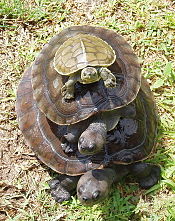
The giant Asian pond turtle inhabits rivers, streams, marshes, and rice paddies from estuarine lowlands to moderate altitudes throughout Cambodia and Vietnam and in parts of Laos, Malaysia, Myanmar and Thailand.

The Indian narrow-headed softshell turtle, also known as the small-headed softshell turtle or the Indo-Gangetic softshell turtle, is an endangered species of softshell turtle native to waterways and rivers of the Indian subcontinent. It is very large, feeding on fish, frogs, worms, crustaceans and molluscs, and even the occasional swimming small rodent or other mammal. C. indica, like other softshell turtles, uses it flexible shell to dig itself deep into sandy lake and river bottoms; here, it patiently waits for potential prey to swim by. They will also ambush and chase their prey, depending on availability, the time of year, and size of the prey. In the past it was included as a subspecies of Chitra chitra, a species restricted to Southeast Asia using current taxonomy.

The Indian flapshell turtle is a freshwater species of turtle found in South Asia. The "flap-shelled" name stems from the presence of femoral flaps located on the plastron. These flaps of skin cover the limbs when they retract into the shell. It is unclear what protection the flaps offer against predators. Indian flapshell turtles are widespread and common in the South Asian provinces. It is morphologically an evolutionary link between the softshell and hardshell aquatic turtles. Exploitation for profit and habitat change are threats to their survival.

The Indian softshell turtle, or Ganges softshell turtle is a species of softshell turtle found in South Asia in rivers such as the Ganges, Indus and Mahanadi. This vulnerable turtle reaches a carapace length of up to 94 cm (37 in). It feeds mostly on fish, amphibians, carrion and other animal matter, but also takes aquatic plants. This turtle is listed in part II of Schedule I of the Wild Life (Protection) Act, 1972 and possession of this species is an offence.

The Indian tent turtle is a species of turtle in the family Geoemydidae. The species is found in India, Nepal, and Bangladesh.

The northern river terrapin is a species of riverine turtle native to Southeast Asia. It is classified Critically Endangered by the IUCN and considered extinct in much of its former range.

The Amboina box turtle or Southeast Asian box turtle is a species of Asian box turtle.

The black pond turtle, also known as the spotted pond turtle or the Indian spotted turtle, is a species of freshwater turtle endemic to South Asia. It belongs to the monotypic genus Geoclemys.

The Cochin forest cane turtle, also known as Kavalai forest turtle, forest cane turtle or simply cane turtle, is a rare turtle from the Western Ghats of India. Described in 1912, its type locality is given as "Near Kavalai in the Cochin State Forests, inhabiting dense forest, at an elevation of about 1500 feet above sea level". Only two specimens were found at that time, and no scientist saw this turtle for the next 70 years. It was rediscovered in 1982, and since then a number of specimens have been found and some studies have been conducted about its phylogeny and ecology.
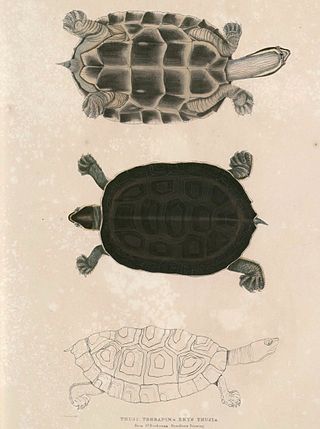
The brahminy river turtle or crowned river turtle is a species of turtle in the family Geoemydidae. The species is endemic to South Asia.

The spiny softshell turtle is a species of softshell turtle, one of the largest freshwater turtle species in North America. Both the common name, spiny softshell, and the specific name, spinifera (spine-bearing), refer to the spiny, cone-like projections on the leading edge of the carapace, which are not scutes (scales).
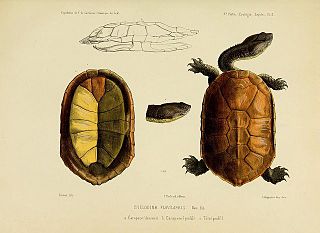
The Brazilian snake-necked turtle, locally known as cágado da serra, and also commonly known as Maximilian's snake-necked turtle, is a species of turtle in the family Chelidae. The species is endemic to southeastern Brazil. It is one of the smallest Brazilian freshwater turtles reaching a maximum straight carapace length of 20 cm (7.9 in). The species prefers streams with sandy and rocky bottoms and clear water in forests above 600 m (2,000 ft) elevation.
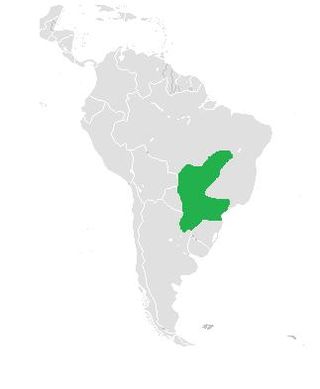
Vanderhaege's toad-headed turtle is a species of turtle in the family Chelidae. The species is endemic to South America.

Cyclemys is a genus of freshwater turtles, commonly referred to as Asian leaf turtles, from the family Geoemydidae. The genus occurs throughout Southeast and South Asia, and currently contains seven species.

The false map turtle is a species of turtle endemic to the United States. It is a common pet species. Two subspecies are recognized, including the nominotypical subspecies described here.
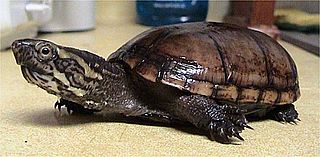
The eastern mud turtle or common mud turtle is a common species of turtle in the family Kinosternidae. The species is endemic to the United States. There are two recognized subspecies.

Maduru Oya National Park is a national park of Sri Lanka, established under the Mahaweli development project and also acts as a catchment of the Maduru Oya Reservoir. The park was designated on 9 November 1983. Providing a sanctuary to wildlife, especially for elephants and protecting the immediate catchments of five reservoirs are the importance of the park. A community of Vedda people, the indigenous ethnic group of Sri Lanka lives within the park boundary in Henanigala. The park is situated 288 kilometres (179 mi) north-east of Colombo.

Melanochelys is a genus of turtles in the family Geoemydidae. Members are found in India, Myanmar, Bangladesh, Sri Lanka and Nepal.

The Southeast Asian softshell turtle is a species of softshell turtle in the family Trionychidae.
























